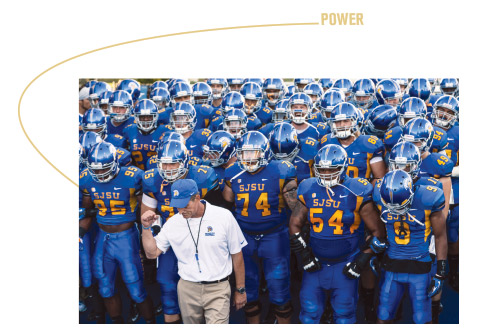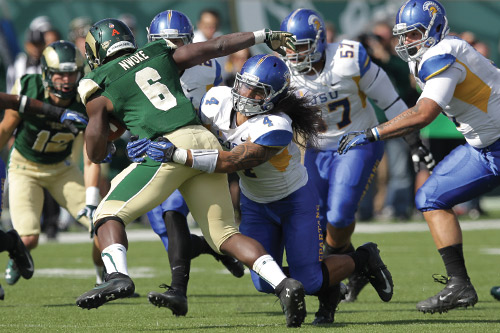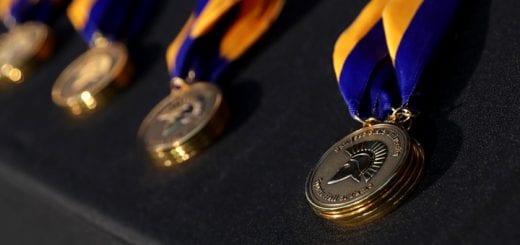Next-generation Spartans

The reasons to leave the University of San Diego and become the 28th head football coach at San José State last winter were many for Ron Caragher. Although San Diego was beautiful and he had loads of success replacing current 49ers’ head coach Jim Harbaugh—44 wins, 22 losses, three Pioneer Football League titles in six seasons—SJSU’s appeal was too great to pass up.
A South Bay native and former quarterback at Bellarmine Prep in San José, the square-jawed, dimple-faced 46-year-old isn’t afraid to admit he’s a homebody—he and wife Wendy have three teenage sons—or that he loves his mom. He was raised in a single-parent home by his mother Marilyn. “My mom still lives in the house I grew up in Morgan Hill. Coming home always feels good,” Caragher admits.
Though some might have seen “coming home” to a program on a major upward spiral as a no-win, jump-into-a-fire proposition, Caragher last spring said that he was willing and able to somersault straight in—and stay in, no matter how long or challenging the transition may be.
Midway through the season, the Spartans had as many wins as losses to open his SJSU coaching tenure. Road wins at Hawaii and at Colorado State gave fans reason for optimism the rest of 2013—as Caragher and the Spartans still had their sights on a Mountain West Conference championship run.

“I love challenges,” he says. “I see nothing but growth and feel nothing but excitement here.”
Caragher isn’t just talking about the football program.
As befits a university located in Silicon Valley, world renowned for its high tech industry, SJSU continues to take advantage of technological advances and partnerships, such as the university’s collaboration with edX, a not-for-profit online learning enterprise, and a five-year, $28 million initiative with Cisco and Nexus IS Inc. to upgrade the campus information technology infrastructure.
“Silicon Valley is the Mecca of all advancing things. There’s such great creativity here. It’s neat to be in the heart of it,” Caragher says.
The digital age has certainly affected the way Caragher and his nine full-time assistants—including defensive coordinator Kenwick Thompson, 44, and 59-year-old tight ends coach and recruiting coordinator Terry Malley—do their jobs.
The painstaking days of splicing together 16 mm game film—“I always felt like I was in art class,” Caragher said of the tedious process—are long gone and have been replaced with simple keystrokes on a laptop, thanks to innovative software applications and solutions from leading digital companies like XOS Digital and Hudl. The results, thanks to this and numerous other technological advances, are far more efficient and time-saving coaching approaches to game planning, recruiting, practice and communication with players. “And, we’re saving trees,” Caragher says.
At your fingertips
Thompson says the biggest and best way technology has enhanced coaching is getting out what he called “real time information”—the amount of time it takes for data to be produced by coaches and then received by players.
Thompson returned to the Spartans after spending five seasons (2007-12) coaching linebackers at Cal. He coached six seasons (2001-06) at SJSU in a variety of capacities. When Thompson played at Nimitz High School in Houston, Texas (1984-86), he saw game film go from reel-to-reel projectors to video in either VHS or Beta format.
“We thought it was great, but you still had to edit it by hand by using time codes. A play would start at, say, 0002 and end at 0006. You had to write all those things down, then cut it up based on a timeline,” he says.
Each of those plays or sequences—called “cut-ups”—would take approximately two or three hours to complete, according to Caragher. “Now you just type in the information and pull it up. A matter of 10 seconds and it’s right at our fingertips,” he says. “Studying your opponents and watching video of ourselves at practice is how technology has affected coaching the most.”
Calculating tendencies also takes a lot less time, says Malley, the son of legendary Santa Clara University coach Pat Malley and grandson of former USF coach George Malley. Terry Malley replaced his father at Santa Clara in 1985 and has been coaching 33 years, the last four at SJSU. He was one of two retained from Mike MacIntyre’s staff—the other is Fred Guidici, who previously coached special teams and running backs. “You click on one column and all opponents’ tendencies come up and it takes two seconds,” Malley says. “Before it would take hours and hours.”
Malley says in the old days with smaller staffs there just wasn’t enough time to do all the numbers. “In the back of your mind, that always scared you,” he says. “Now you can say unequivocally something happens 10 percent of the time. It allows you to make a good decision based on accurate information.”
More answers
But there’s also much more information to be taught and learned. Even though software and computers save time, Malley says that doesn’t translate into more downtime for coaches.
“I think in many respects, you end up working more hours because your competition has more accurate information as well,” he says.
For players, taking in the data is more accessible in cyberspace but the amount of data is also immense. “It’s no different than the Internet itself,” Thompson says.
Though Caragher says he still prints out a playbook, Thompson says his defensive players have access to iPads where game plans and interactive lessons are taught. “They can see the offenses they are going up against and the statistics based off plays in each formation,” Thompson says. “They can click on a button and actually see the play.”
Thompson says he has the ability to offer voice-overs as the play unfolds. “I can tell him when to blitz versus a particular formation and explain what to do. He can get all this information while he’s sitting at home.”
While the university doesn’t supply iPads to players yet, like many Pac-12 schools, Caragher says, it’s coming soon. “The cost for iPads for 105 players is exorbitant, but down the road when people see the bigger picture it makes sense and saves money.”
Thompson says it’s vital that coaches keep the information flow fresh, interactive and coming from many directions for the new generation of players who grew up on video games. “When they don’t have it coming at them in waves, they get bored and easily distracted,” Thompson says. “You have to keep their attention, and being able to use different vehicles and making it interactive helps.” At SJSU, he says, “we take pride in being on the cutting edge to make sure through technology that players receive information in a better way.”
Human element
 In the past, lack of time, communication or information lost recruits even before they arrived at SJSU. It wasn’t a situation unique to SJSU—it happened everywhere. But rarely does it happen anymore. When Caragher started recruiting in the 80s, potential recruits would mail in entire game tapes that the college coach would sift through to find highlights. The coach was then supposed to duplicate the tape and mail it back.
In the past, lack of time, communication or information lost recruits even before they arrived at SJSU. It wasn’t a situation unique to SJSU—it happened everywhere. But rarely does it happen anymore. When Caragher started recruiting in the 80s, potential recruits would mail in entire game tapes that the college coach would sift through to find highlights. The coach was then supposed to duplicate the tape and mail it back.
“We had a whole storage room full of video tapes, and we had to decide at the end of the year if we wanted to keep them in case there was another prospect on it,” Caragher says. “Now we’ve gained our whole closet space back. It’s all in cyberspace.”
Current recruits email coaches a video link. No postage required. “You just need to be aware of all the bells and whistles on the tape and turn down the music,” Caragher says.
Often it’s not even necessary to wait for the link, Malley says. “If you hear a recruit’s name, you can tap into a Hudl or YouTube account and get his information within two minutes. In the past, getting that transcript and all the other things was a week-long process.”
“While all the film and highlight video is welcome, it’s of the utmost importance to get to know the prospect and see if he’s a fit in our program,” Caragher says. “The culture of the locker room is the most important aspect of a championship program.”
Malley agrees whole-heartedly and believes it’s a big reason the Spartans had record-breaking success under the old regime.
“The more times I have a chance to see and meet recruits in person, the better chance I have to make a better decision on him,” he says. “The business has changed so drastically. We’re making offers to kids so much faster. At San José State, our philosophy is to ‘offer slower’ than most people, and to know who we are offering to and why we are offering.”
Mitch Stephens is a senior writer and national columnist with MaxPreps.com and prep sports content provider for the San Francisco Chronicle.
Help pack Spartan Stadium for the season’s last home games on November 9, 22 and 29. Get tickets now!




1 Response
[…] San Jose State ministry of propaganda has a piece about how technology is changing how coaches do their jobs, with Ron Caragher and Co. as examples. Piece is by Matt Stephens, who works for MaxPreps and […]